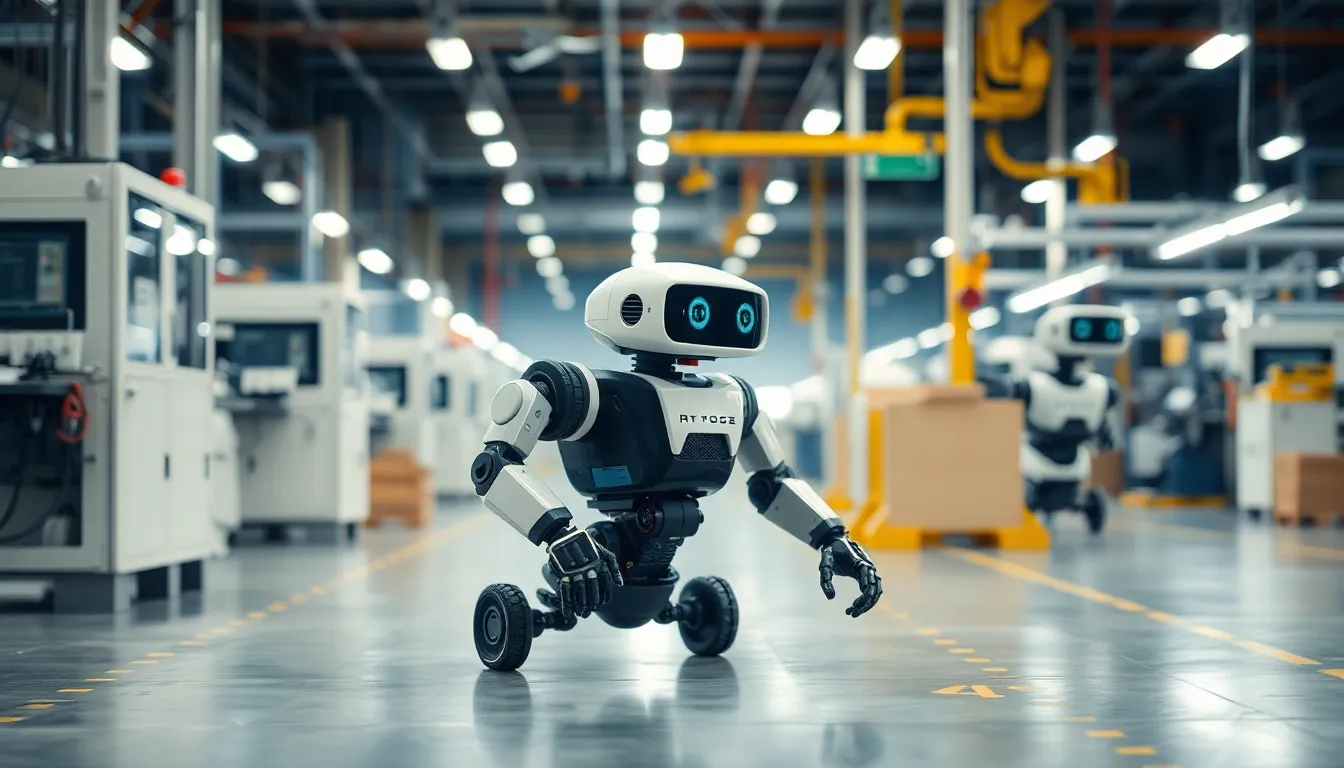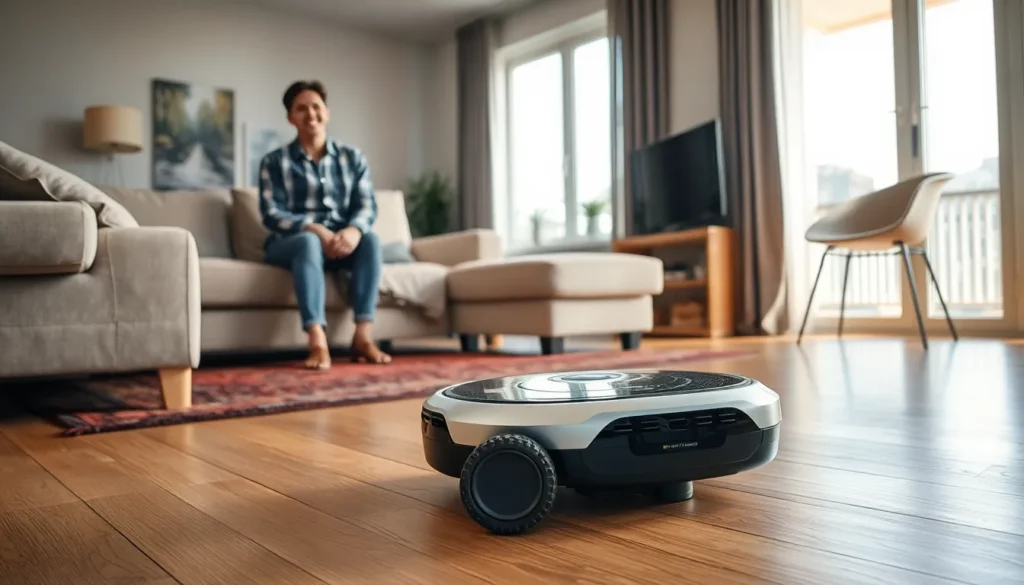In a world where robots are no longer just the stuff of sci-fi movies, robotics sensors are the unsung heroes making it all happen. These tiny technological marvels help machines see, hear, and feel, turning them from clunky metal boxes into responsive companions. Imagine a robot that can dodge your cat while vacuuming—now that’s some serious sensor magic!
Table of Contents
ToggleOverview of Robotics Sensors
Robotics sensors play a critical role in enabling robots to interact with their environments effectively. These devices collect and process information from surroundings, allowing automated systems to make informed decisions. Various types of sensors exist, including proximity sensors, cameras, and accelerometers, each serving distinct functions.
Proximity sensors detect nearby objects or obstacles. They utilize methods like infrared light or ultrasonic sound to measure distances. Cameras capture visual data, enabling robots to recognize objects and navigate complex environments. Cameras perform image processing to identify shapes, colors, and movements, enhancing navigational accuracy.
Accelerometers measure the orientation and acceleration of robots. This information aids in maintaining balance during movement. Additionally, gyroscopes complement accelerometers by providing rotational data, making it easier to control robotic stability. Both components are essential for robots that perform dynamic tasks.
Lidar systems represent another advanced option for sensing. This technology utilizes lasers to map surroundings, creating detailed 3D representations. Robots equipped with Lidar can navigate large areas with precision, avoiding obstacles and efficiently reaching designated targets.
Sound sensors also contribute to robotic interactions. By interpreting sounds, these sensors allow robots to respond to voice commands or environmental noises. This capability enhances communication and engagement with users, making robots more intuitive companions.
Each sensor type significantly impacts a robot’s operational capabilities. As technology advances, integrating various sensors promotes smarter, more responsive robotic solutions. The combination of these sensors enables robots to function seamlessly in diverse environments, transforming them into valuable tools in daily life and industry.
Types of Robotics Sensors

Robotics sensors play a crucial role in how robots interact with their environments. Various types facilitate precise perception and reaction to stimuli.
Proximity Sensors
Proximity sensors locate nearby objects without physical contact. They utilize methods such as infrared light or ultrasonic sound waves to detect presence. This technology helps robots avoid obstacles while traversing their surroundings. Many industrial robots rely on proximity sensors for safe navigation in confined spaces. The integration of these sensors enhances robots’ ability to operate efficiently in dynamic environments.
Vision Sensors
Vision sensors capture visual information, allowing robots to recognize objects and navigate effectively. Cameras equipped with advanced image processing technologies interpret data to distinguish colors, shapes, and movements. Robots often employ vision sensors for task execution, such as sorting items or identifying hazards. This capability significantly improves functionality in applications ranging from manufacturing to healthcare. Accurate vision sensing combines with other sensors to augment a robot’s decision-making processes.
Force and Torque Sensors
Force and torque sensors measure the amount of force applied to an object and the rotational forces exerted during movement. These sensors contribute to precise control and manipulation in robotic systems. They enhance feedback for tasks requiring dexterity, such as assembly or delicate object handling. A robot equipped with these sensors adjusts its actions based on real-time data, resulting in increased safety and accuracy. Such technology is vital in applications like robotic surgery or automation in warehouses, where precision is essential.
Applications of Robotics Sensors
Robotics sensors play a crucial role in various industries, enhancing operational efficiency and safety.
Industrial Automation
In industrial automation, sensors facilitate streamlined workflows and ensure precise operations. Proximity sensors monitor machinery and equipment, preventing accidents by detecting workers nearby. Vision sensors enhance quality control by identifying defects on assembly lines. Additionally, force and torque sensors improve assembly processes by gauging pressure applied during operations. These advancements lead to increased productivity while maintaining a safe working environment.
Medical Robotics
Medical robotics relies heavily on sensors to enhance surgical precision and patient care. Force sensors enable surgeons to execute delicate maneuvers during procedures, minimizing tissue damage. Vision sensors assist in imaging, allowing robots to visualize complex anatomical structures. Accelerometers help maintain stability during surgeries, ensuring robots operate smoothly without interruptions. The integration of these sensors results in better outcomes for patients while also improving efficiency in healthcare settings.
Consumer Electronics
Consumer electronics benefit from robotics sensors in multiple ways, enhancing user experience and functionality. Devices like robotic vacuums utilize proximity sensors to avoid obstacles while cleaning efficiently. Smart home devices employ vision and sound sensors for effective interaction, enabling voice commands and facial recognition. These sensors enable seamless integration into daily life, making technology intuitive and user-friendly. As a result, robotics sensors elevate the overall effectiveness of consumer electronics.
Challenges in Robotics Sensors
Robotics sensors face several challenges that affect their performance and reliability in real-world applications. Understanding these difficulties is crucial for advancing sensor technology.
Environmental Factors
Environmental conditions such as temperature, humidity, and light can interfere with sensor accuracy. Proximity sensors may struggle in extreme temperatures, causing readings to fluctuate. Vision sensors experience difficulties when exposed to varying light levels, impacting object recognition. Moreover, dirt, dust, and moisture can hinder operation, particularly for cameras and Lidar systems. Adapting sensors for different environments becomes essential to ensure consistent performance outdoors and in dynamic environments.
Accuracy and Reliability
Achieving high accuracy and reliability in robotics sensors presents ongoing hurdles. Sensor drift and noise can lead to erroneous readings over time, affecting decision-making processes. Calibration is often necessary to maintain precision, which can complicate development. Sensor fusion methods can help mitigate these inaccuracies, but integrating multiple types simultaneously increases complexity. Achieving reliable performance across varied conditions remains a priority, as it directly impacts a robot’s effectiveness in tasks like navigation and manipulation.
Future Trends in Robotics Sensors
Rapid advancements shape the future of robotics sensors. Innovations in artificial intelligence enhance the capabilities of these sensors, allowing for more intelligent data processing. Increased integration of machine learning algorithms significantly improves sensor accuracy and adaptability, enabling robots to learn from their environments.
The demand for advanced proximity sensors continues to rise. Emerging technologies such as LiDAR and radar systems offer enhanced object detection and mapping functions. Adoption of these technologies will facilitate more complex navigation tasks, particularly in advanced fields like autonomous vehicles and drone operations.
Miniaturization of sensors plays a crucial role in robotics development. Smaller sensors allow for more compact and lightweight robotic designs, enhancing portability. This trend provides opportunities for robotics in consumer applications, such as wearable devices and compact service robots.
Sensor fusion techniques will gain prominence in robotics systems. By combining data from different sensor types, robots can achieve improved environmental perception. This capability leads to enhanced decision-making processes, particularly in dynamic and unpredictable settings.
Environmental adaptability remains a key focus for future robotics sensors. Developments in materials and coatings can help sensors resist challenges from temperature, humidity, and dust. Enhanced durability ensures better performance in various applications, from agriculture to disaster response.
Data security is also crucial in the evolution of robotics sensors. With increased connectivity, safeguarding sensor data against cyber threats becomes a priority. Future designs will incorporate advanced encryption methods to protect sensitive information, ensuring the safety of autonomous systems.
These trends collectively indicate a future where robotics sensors become more intelligent, versatile, and reliable. Enhanced capabilities make these sensors vital for various industries, revolutionizing how robots interact with their surroundings.
Robotics sensors are at the forefront of innovation in the field of robotics. Their ability to enhance perception and interaction with the environment transforms robots into dynamic companions capable of performing complex tasks. As advancements in technology continue to emerge the future of robotics sensors looks promising.
The integration of AI and machine learning will further refine their capabilities making robots more intelligent and adaptable. With a focus on improving reliability and performance in diverse conditions the role of sensors in robotics will only grow. This evolution not only enhances operational efficiency but also opens new avenues for applications across various industries. As these technologies develop the impact of robotics sensors will be felt in everyday life and professional settings alike.





